Choosing Garden Containers
Choosing the best garden containers for your garden is as important as selecting the plants you will put in them. You can showcase your flowers and foliage by choosing the right container in which to display them.
You also want to make sure you choose the right size of pot or planter to insure your plants' best performance
The wrong-sized container or one that is made of unsuitable material could leave you with a garden of yellowing or wilted plants in a few weeks.
Pick a suitable planter in the beginning and make sure it is clean and sanitized. Never reuse a pot without cleaning it first - you may infect new plants with disease or pests.
Finally, where you want to place the container and what you want the container garden to accomplish for you is important when making your selections.
Which type of garden containers will work best for you?
All garden containers have advantages and disadvantages, depending on your container gardening goals, the types of plants you will be using, and where you will place your container.
Baskets - they are lightweight and great for planting annuals. Baskets can be hung almost anywhere so they don't take up valuable floor space in small areas. They are generally not as deep as other containers, and if they are hung, they are exposed to wind so watering frequently is needed.
Boxes - they are one of the best garden containers for shrubs, trees and larger perennials since their squared off shapes allow for more root growth. They also work well for growing vegetables, especially those that are tuberous like potatoes, carrots, turnips, etc that grow beneath the ground and need deeper soil. Boxes come in lots of materials. They can also be placed as window boxes, rail and fence planters.
Troughs - these are a lot like boxes, but generally are more shallow. Traditional troughs are made of concrete, but you can also find them in lighter weight materials now and can even make your own. Antique troughs that were actually used for feeding livestock can be quite pricey. These are the best garden containers for growing succulents or alpine gardens if you find one.
Pots and urns - there is an almost limitless supply of pots and urns in all different sizes, styles, materials and colors. They range from traditional styles with graceful curves to geometric shapes that complement contemporary homes.
Come of the best garden containers are those vessels that have outlived their original use and can be converted to planters. Use old wicker baskets, leaky galvanized buckets, watering cans, wheel barrows – use your imagination.
Size matters
The larger the garden container, the better it will be for growing plants. However, if you plan to move the garden containers and pots from one area to another for any reason, avoid heavy planters made of materials like concrete.
If you garden on balconies, decks or rooftops, keep in mind that big, heavy plant containers weigh a lot when filled with rocks for drainage, soil, plants, water and any kind of mulch or pebble. Make sure your floor is going to support a large container before you decide to use one. Baskets are a good choice.
Take measurements and decide before you shop how much area you want a pot, box or basket to cover. Garden containers always look bigger in the store. Measure your deck, railing, porch or balcony area and keep those numbers with you.
The best garden container will complement its location
Deciding where to place your container garden is a big factor in container selection. Tubs, pots, boxes, planters and baskets can all complement the right location.
There are all kinds of areas around the house and yard for container gardens. Some of the first that come to mind are porches, decks and balconies, but so are patios, terraces and driveways. Paved paths, walks and in-ground flower beds are others. Fences, retaining walls and carports offer nice spots. Homes with pools, barbecue pits and outdoor kitchens have great spots for container gardens both for decorative appeal and practicality.
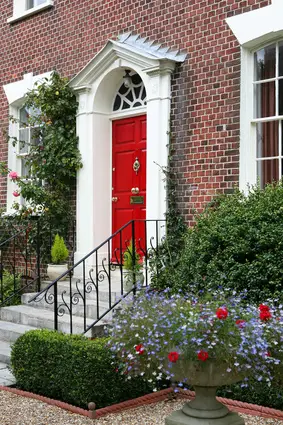
Think about the placement of your plant containers and what you want them to do for you. Will you be creating a welcoming entry or using plants in containers to separate two outdoor living areas? Or, do you want to plant herbs or vegetables for practicality, but have them be pleasing to the eye as well?
Don't you love the look of this entry area? The urn is too big to use right by the front door, so small shrubs anchor the door. The urn is used in the larger area leading to the entry. Just a touch of red in the container coordinates with the front door. It only takes the one well coordinated, well placed pot to create great impact and curb appeal at this home.
Does the container complement its contents
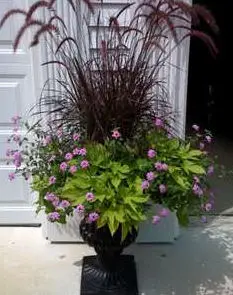 |
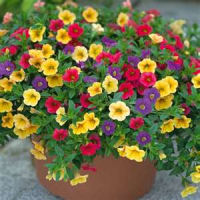 Tall, arching grasses look great in a tall, curvy urn, while mounding annuals, like the petunias look best in a rounded container that is about 2/3 the height of the flowers. |
Watch the scale - don't upset the balance
The best garden container will be chosen based on the size of the plants and where the pot will be placed. Scale is
important for balance in your container garden.
A tall plant in a little pot looks awkward; short, airy flowers would be
dwarfed in a large, heavy planter. In
the same regard, you wouldn’t want to set two little planted pots on either
side of a front entry with a heavy oak door. They would have no impact at all. Huge concrete containers on a small deck
would be just as ineffective.
The best garden containers for small areas might be small pots or boxes that can be displayed in a grouping. Use pottery feet, bricks, or plant stands to raise the containers and pots to different heights. This is pleasing to the eye but also adds depth and definition to your garden.
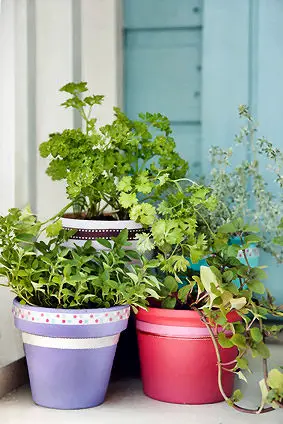
Different sizes, shapes and colors of pots and urns are fine for groupings, but make sure all of the containers have something in common - color, shape, or material. This keeps the grouping from looking too "hodge podge" and has more visual appeal. The pots for these vegetables are all made of clay and have pretty much the same shape although they have been painted different colors.
If you have containers that you want to use for gardens, but they are made of materials that will rust, or disintegrate after being exposed to water, use a plastic pot for planting and just set that inside the decorative pot.
You can apply several coasts of a weatherproof sealant to woven, wooden or some metal containers. Remember that just painting a pot does not make it waterproof.
What do you want the container to accomplish?
When it comes right down to it, selecting the best garden container depends on what you want it to do for your outdoor areas.
Do you want the container to be a part of the display? Are you choosing planters for their color, motif or design – to go with the patio furniture or the color of the house?
Or do you want to use containers as you would a garden bed – a spot of dirt where you will plant beautiful flowers or foliage? If so, maybe your container is just that – a container – and you want it to blend into the background or hide it completely – the choice is absolutely yours.
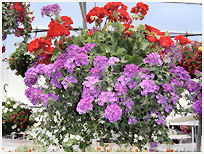 In these hanging basket and window box displays, the look of the container is unimportant. |
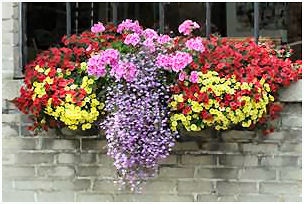 |
Containers with saucers can contribute to root rot. The saucers collect water and cause the potting mix at the bottom of the container to stay soggy. If you like to use saucers, bill them with gravel before positioning your pot on them. That way, the pot will never sit in standing water.
So choose your container wisely and let it help you accomplish your gardening goals.
Consider baskets, boxes, troughs, pots and urns.
Return from Garden Containers to Container Gardening Design
Return Home enjoycongainergardening.com
Gardening Resources
Click the link below to visit my aStore @ Amazon -
Books & How To Help
Garden Tools & Supplies
Online Plants
Anything that will hold water, soil and plants can be made into a container garden.
Here are some fun containers-






Have your own unique or interesting container? Please share it at the bottom of this page.

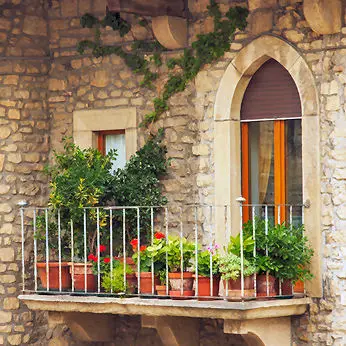
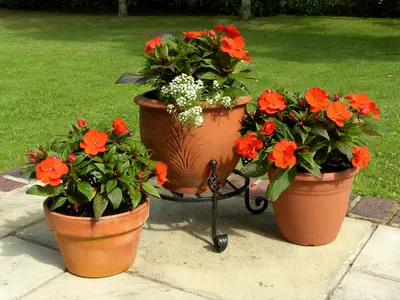
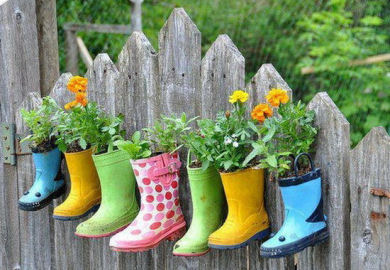
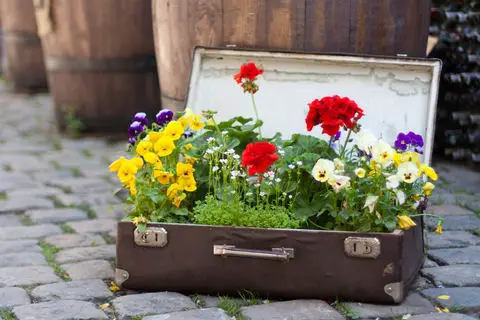

New! Comments
Please leave me a comment and let me know if you like what you see here and if the information is helpful. Thanks.